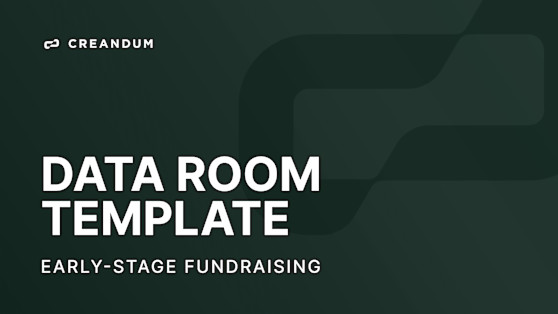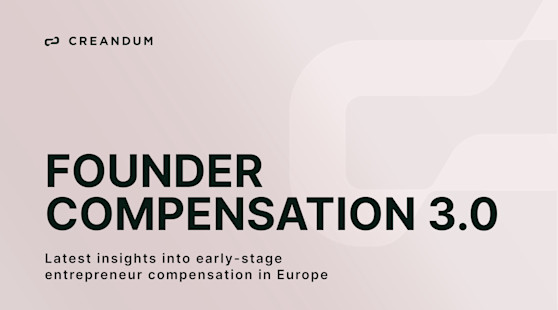
Employee Share Option Plans (ESOPs) matter. They allow startups to attract and retain top talent. They make employees owners with a direct, vested interest in their company’s success; and, following exits, they help provide funding sources for the next generation of startups.
For many years, Germany had one of the worst taxation regimes for ESOPs, making it virtually impossible for startups to offer them, placing the German tech ecosystem at a disadvantage to Silicon Valley and other global centers of innovation. After much campaigning, we all celebrated the coming into force of the Future Financing Act in January 2024 which solved many of the issues with Section 19a of the German Income Tax Act (which was introduced in 2021 to make ESOP schemes more attractive).
However, this is just the beginning. Although Germany has now caught up with other jurisdictions for ESOPs, the law needs to be put into practice and it is fiendishly complicated.
This is why we are proud that Billie, one of our portfolio companies, has become the first company in Germany to translate the new law into practice with a model for employee share ownership that has been approved by the Berlin financial authorities. All Billie employees will now have the opportunity to share in the company’s future growth prospects.
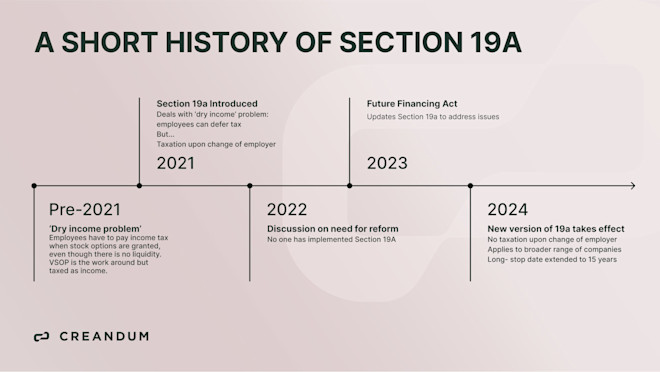
The evolution of ESOP in Germany
Introducing Patient Zero: Billie
Berlin-based Billie has built an incredible product to bring the benefits of Buy Now, Pay Later to the business-to-business space. Billie’s leadership including general counsel, Aiga Senftleben, believe that being a first mover on ESOP and activating the benefits of the new law would be a competitive advantage to attract the best talent.
Since January, a couple of different schemes have been proposed to deliver the tax advantages of Section 19a. The challenges with these schemes are that they are either very complex to administer or the governance associated with issuing shares makes them only applicable to senior leaders in a company. For Billie, it was critical that any ESOP scheme would bring the benefit of ownership to all employees.
So, together with the law firm, V14, and tax consultants, FGS, they built their own model based on ‘Profit Participation Rights’ (PPRs, in German: Genussrechte). The model has been approved by the Berlin Financial Authorities and Billie will now transition from issuing VSOPs to ESOPs via PPRs.
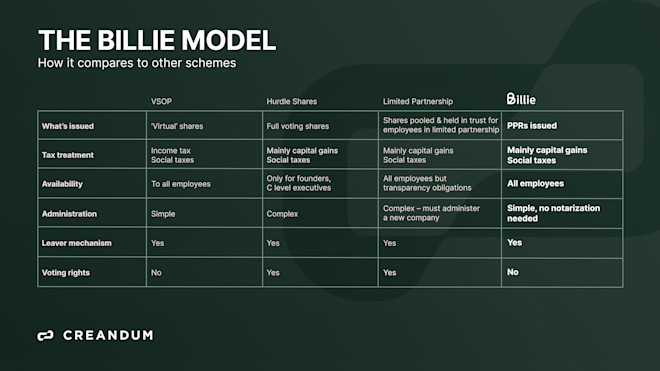
Comparing the Billie model
Our friends at V14 and FGS, along with Aiga, recently hosted a webinar on this topic for our German portfolio companies on how their model works. We wanted to share this content with the wider world so more companies can use it as a path to ESOP. It’s a complicated topic so you should still seek individual legal and tax advice for your company’s position. Disclaimer: The following content is not legal advice.
How does the Billie Model Work?
Profit Participation Rights (PPR) is a financial instrument held individually by the employee which allows holders to receive a share of the company’s profits or liquidation proceeds. The key benefit of the approach is that it combines the advantages of the new tax treatment (ie. capital gains) with the simplicity of ‘virtual shares’.
There are four key components that the tax authorities will accept for a PPR scheme:
1. Financing instrument - It needs to have a financing function, (compared to VSOP which does not). At least a small amount of funds must be paid in by the employee. For example, if the fair market value of the PPR is 100, the employee can pay in somewhere between 3 and 5% for it to be accepted.
2. There should be no administrative shareholder rights associated with the PPR.
3. You must request a Wage Tax ruling from the local tax authorities.
4. Typical shareholder financial rights - The instrument will have similar rights as shares in terms of right to distributions, not only in case of exit but also for any profit distribution before an exit (compared to VSOP where you can exclude right to profit distributions / dividends).
How do PPRs compare to VSOP?
For the most part, existing VSOP schemes are easily adaptable to PPR and 80-85% of the terms and conditions will be the same. There are two important aspects to consider with PPR:
1. As the name implies, profit distribution conditions must be included in the contract - ie. PPRs would also receive distribution if the company pays out dividends. This is unlikely to be an issue for the majority of companies who at the stage of issuing ESOPs are in growth mode and quite far away from paying out dividends.
2. Strike price - under the new 19a regime, share grants must either be free or significantly discounted from the share price at the time of the last fundraise. This means that you can likely not set the strike price at the fair market value (FMV), compared to VSOP where you are free to set the strike price at any level.
Are you eligible for PPR?
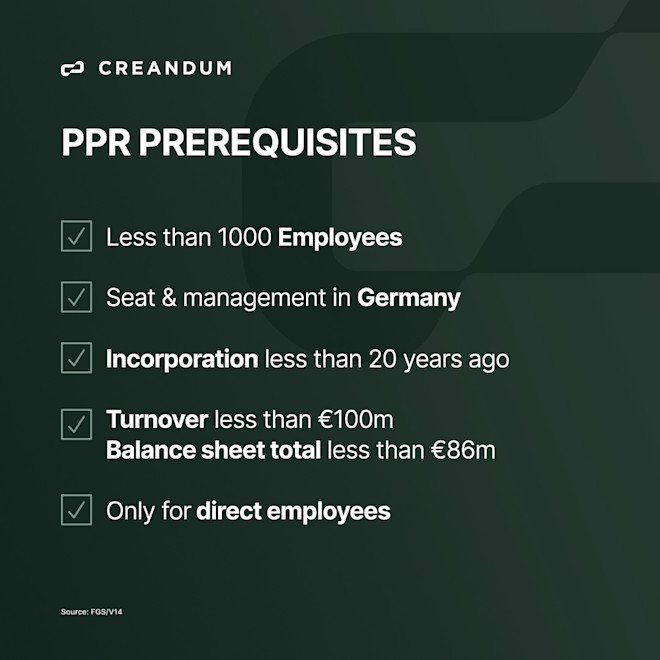
PPR Eligibility
Implementing a PPR
The general terms and conditions for PPR should be drafted as a financing instrument so not dissimilar from those you might see in an investment contract, but without the shareholder rights.
In addition to the overall terms of the scheme, you will need an allotment offer for the individual employee that covers such things as vesting provisions, repurchase options or anything else you might want to include.
Once the scheme has been set up, there are two new processes companies will need to factor in:
Inform the financial tax authorities about PPR issuance.
Provide valuation information to the payroll provider for income tax calculations. It is very important to keep close track of individual grants and valuation so you can work out which parts should be taxed as income and which as capital gains when an exit occurs (see below).
In Billie’s case they issue PPRs twice a year so only have to run the full process of valuation, receiving employee funds and reporting to the authorities twice annually.
How does the taxation of PPRs work?
The PPR consists of 2 portions:
(a) The grant value. Let’s say that the PPR is worth 100 based on the fair market value of the company at time of grant. And to participate in the PPR, the employee must pay 5%. The remaining 95% is treated and taxed as income (also including wage taxes). But importantly, this income tax payment is deferred until an exit takes place, avoiding the previous ‘dry income’ issue.
(b) From grant value to exit valuation - The increase in value of the PPRs from time of grant to exit is subject to capital gains tax.

PPR Taxation
How is FMV established?
If there has been a financing round or major secondary sale within the last 12 months, that valuation can be used. In the cases where there is not a clear or recent view of the company’s value, when you report the issuance of PPRs to the tax authorities, you can request they give you a valuation, and they must do so within 6 months from your request and filing.
What happens to existing VSOP schemes?
If you already have VSOP in place for employees, there are a number of options to consider:
You can keep the existing VSOPs in place and have a financial cap at current fair market value for the VSOP and then issue PPRs using the same fair market value as a starting point.
You could cancel existing VSOPs with no tax triggers and replace with PPRs.
You could run both VSOP and PPR in parallel.
Here, it’s important to get legal and tax advice on the right approach for your business.
Are there any downsides?
PPR is a smart model that combines better tax treatment with straightforward administration but it will not suit every business. In particular, PPR may not be right if:
You have a large number of employees working outside of Germany.
You want to issue ESOPs to contractors or freelancers.
You want to keep your valuation close to your chest.
Conclusion
Congratulations to Aiga and the team at Billie for being a first mover on ESOP in Germany. It’s a complex subject and no small undertaking to build a new model from scratch and then have that model approved by the authorities. It’s also incredible to see how willing they are to share the work they have done and provide this path to other companies looking to bring ESOP to their employees. Implementing ESOP will go a long way to help Germany retain the best talent and compete with the best startup ecosystems in the world.

